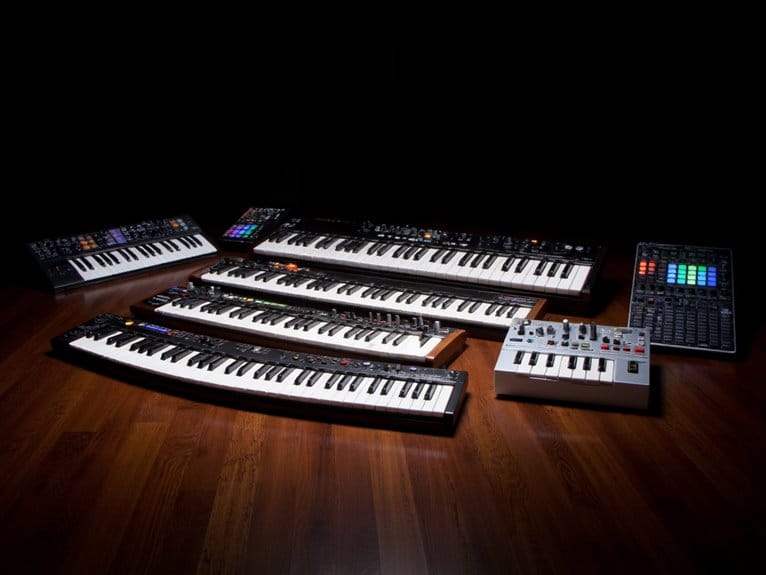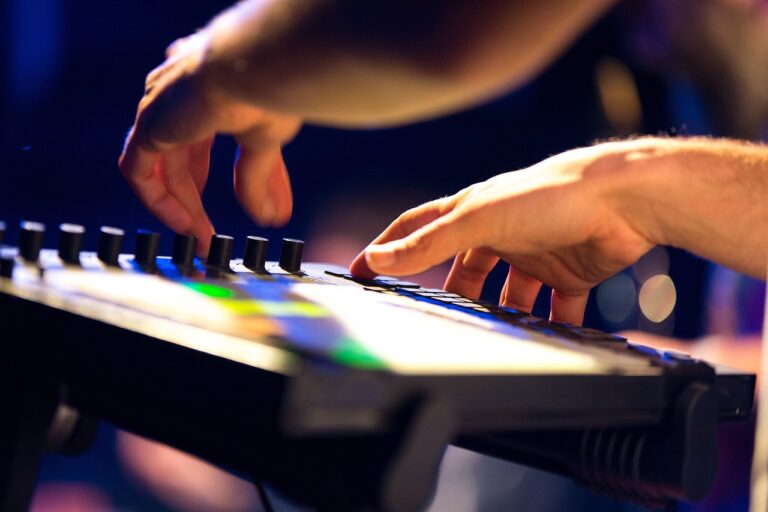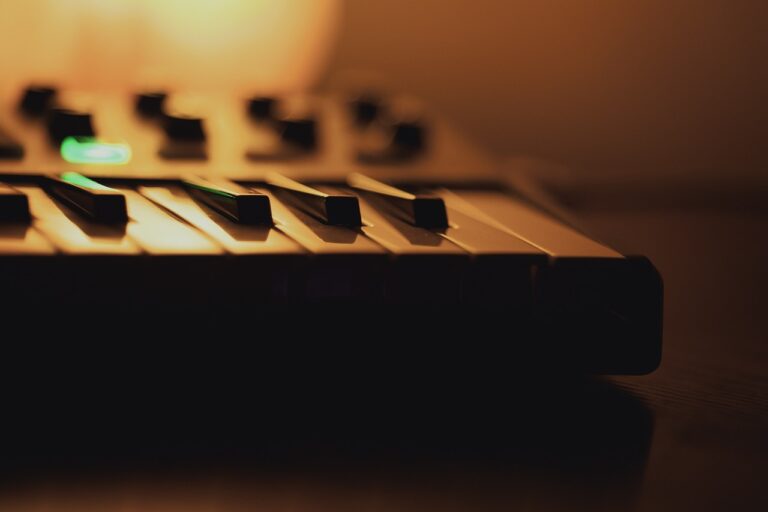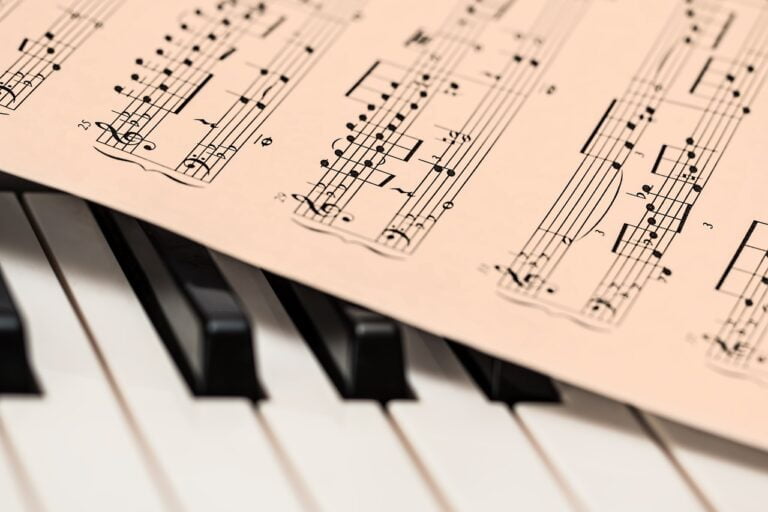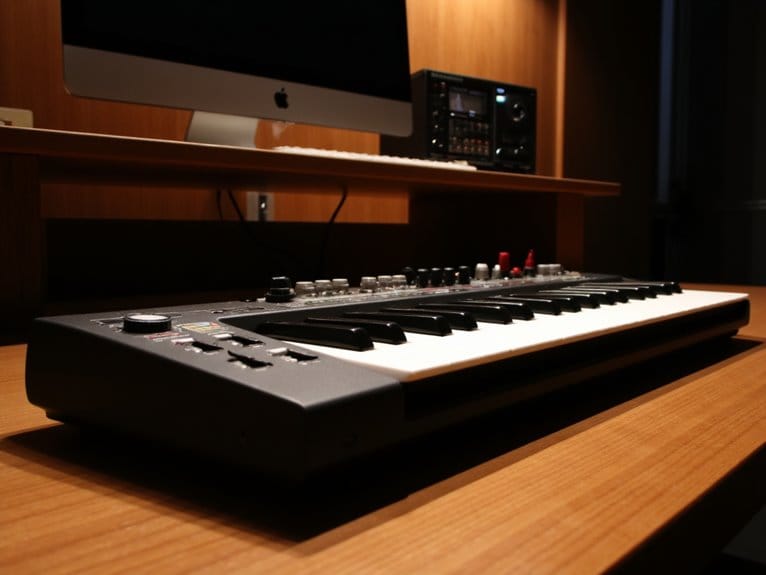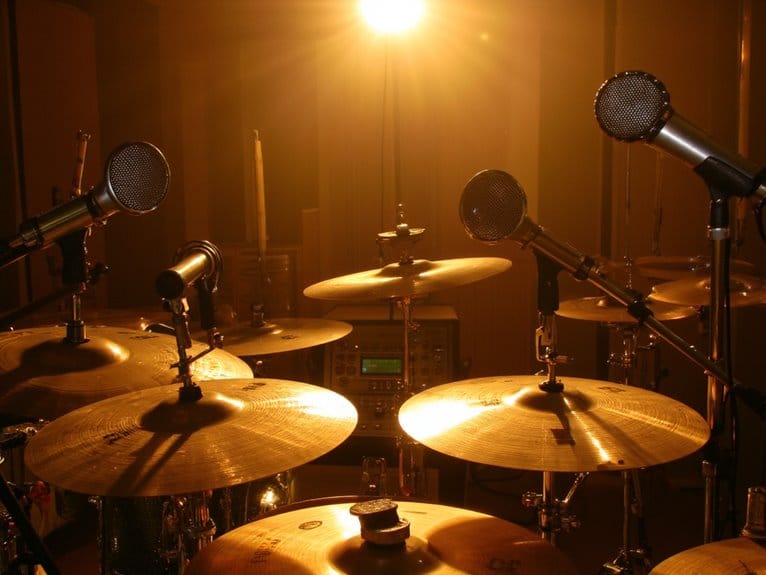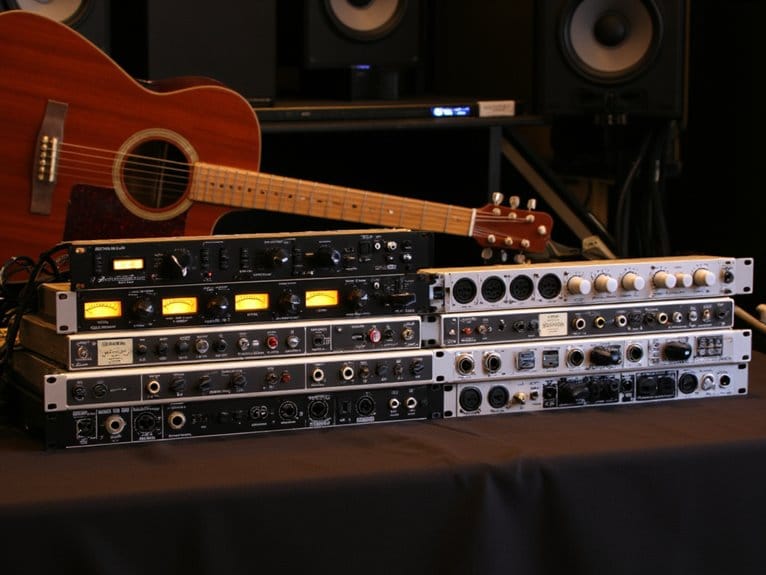10 Best MIDI Keyboards for Music Production and Performance
I’ve tested dozens of MIDI keyboards this year, and the standouts include the Akai MPK Mini MK3 for portability, Novation Launchkey 25 MK4 for seamless DAW integration, and Arturia MiniLab 3 for professional features in a compact design. For full-sized options, the Nektar Impact GX61 offers extensive control, while weighted 88-key models like the Donner OURA DDP-60 provide authentic piano feel. Each excels in different areas depending on your budget, workspace, and production style, so understanding the specific features becomes essential.
We are supported by our audience. When you purchase through links on our site, we may earn an affiliate commission, at no extra cost for you. Learn more.
Notable Insights
- Choose models with velocity-sensitive keys and MPC-style drum pads for enhanced musical expression and dynamic performance control.
- Consider key count based on your needs: 25-key models for portability, 61+ keys for complex compositions and extended playing range.
- Prioritize MIDI keyboards with comprehensive software bundles like MPC Beats or Komplete 15 Select to maximize production capabilities immediately.
- Look for multiple connectivity options including USB, Bluetooth, and MIDI out to ensure compatibility with various devices and setups.
- Set a realistic budget from $50 for entry-level to $1,000 for professional models while focusing on essential features over price alone.
88 Key Weighted Digital Piano with MIDI Functionality

When you’re a beginner stepping into the world of music production, the 88 Key Weighted Digital Piano with MIDI functionality becomes your musical Swiss Army knife, offering the authentic feel of acoustic piano keys through its progressive hammer-action mechanism while seamlessly connecting to your digital audio workstation. You’ll appreciate the French Dream5704 sound chip‘s exceptional audio depth, which transforms your compositions with eight distinct tones and dual-tone capabilities that expand creative possibilities. The recording and playback functions, combined with adjustable reverb, chorus, and tempo settings, provide extensive control over your musical expression while the integrated MP3 player and dual headphone jacks accommodate various workflow preferences.
Best For: Beginners in music production who want an authentic acoustic piano feel with digital versatility, offering both traditional playing experience and modern MIDI connectivity for seamless integration with digital audio workstations.
Pros:
- Progressive hammer-action keys with French Dream5704 sound chip deliver authentic acoustic piano feel and exceptional audio quality
- Comprehensive MIDI functionality with recording/playback, dual-tone mode, and extensive customization options for reverb, chorus, and tempo
- Convenient connectivity features including dual headphone jacks, USB port, integrated MP3 player, and custom triple pedals for professional functionality
Cons:
- Heavy weight at 67.9 pounds makes it difficult to move or relocate frequently
- Limited to only 8 tones which may restrict advanced players seeking more sound variety
- Large dimensions (57 x 18 x 13 inches) require significant space commitment in home or studio setup
M-VAVE 25 Key USB MIDI Keyboard Controller with 8 Backlit Drum Pads (Black)

The M-VAVE 25 Key USB MIDI Keyboard Controller stands out as an exceptional choice for mobile producers and bedroom beatmakers who refuse to sacrifice functionality for portability. You’ll appreciate its extensive feature set, which includes 25 velocity-sensitive mini keys, eight RGB backlit drum pads, and eight assignable rotary encoders packed into just 2.35 pounds. The built-in 2,000 mAh battery delivers approximately 16 hours of wireless operation via Bluetooth, while smart chord and scale functions help streamline your creative workflow. I’ve found the USB-B connectivity surprisingly reliable, though the older connector style feels somewhat dated, and the included Cube Suite app provides decent customization options for serious producers.
Best For: Mobile producers, bedroom beatmakers, music students, and songwriters who need a portable, feature-rich MIDI controller for on-the-go music creation without sacrificing essential functionality.
Pros:
- Excellent portability with 16-hour battery life and Bluetooth connectivity for truly wireless music production
- Comprehensive feature set including velocity-sensitive keys, RGB drum pads, rotary encoders, and smart chord/scale functions
- Strong compatibility across multiple platforms (Windows, macOS, Android, iOS) and major DAWs with customizable settings
Cons:
- Uses outdated USB-B connector style that feels dated compared to modern USB-C standards
- Mini keys may not provide the full playing experience that pianists accustomed to full-size keys prefer
- Compact design may limit the physical control surface area for complex production workflows
Donner OURA DDP-60 88 Key Digital Piano with Three Pedals

Beginners seeking an affordable entry into digital piano playing will find the Donner OURA DDP-60 particularly appealing, since it combines essential learning features with a space-conscious design that won’t overwhelm smaller rooms. You’ll appreciate its full-size 88-key velocity-sensitive keyboard, which provides authentic playing dynamics alongside 128 polyphony for complex musical passages. The instrument offers 128 voices, 83 rhythms, and dual mode for shared playing sessions, making it versatile for both solo practice and collaborative learning. While some serious pianists may find the sound quality lacking compared to higher-end models, you’ll benefit from USB-MIDI connectivity for music production integration and three headphone jacks for flexible monitoring options.
Best For: Beginners and casual players who need an affordable, space-saving digital piano with essential learning features and flexible connectivity options for practice and collaborative playing.
Pros:
- Full-size 88-key velocity-sensitive keyboard with 128 polyphony provides authentic playing dynamics for complex musical passages
- Compact, minimalist design (48.3 pounds) fits well in limited spaces while offering dual mode for shared playing sessions
- Versatile connectivity with USB-MIDI integration and three headphone jacks, plus 128 voices and 83 rhythms for varied practice
Cons:
- Sound quality may be insufficient for serious pianists compared to higher-end digital piano models
- Limited to basic features that may not satisfy advanced players seeking professional-grade performance capabilities
- At 48.3 pounds, still requires consideration for frequent transport despite being more portable than traditional pianos
Fesley Digital Piano 88 Key Weighted Keyboard with Bluetooth & MIDI USB

Budget-conscious producers seeking professional-grade weighted keys will find the Fesley Digital Piano FEP760 delivers impressive value at 37.7 pounds of solid construction, combining 88 full-weighted keys with graded hammer action that mimics grand piano touch sensitivity. You’ll appreciate the French Dream sound source powering 128 tones and 200 rhythms through dual 20W speakers, while MIDI USB compatibility connects seamlessly to DAWs like Ableton Live and GarageBand. The three-pedal system-sustain, soft, and sostenuto-enhances your creative versatility, though beginners might find the weighted action challenging initially. With Bluetooth connectivity, dual headphone jacks, and that attractive wooden finish, it’s honestly hard to find better bang for your buck in this price range.
Best For: Budget-conscious musicians and producers who want professional-grade weighted keys with full connectivity options for both practice and music production.
Pros:
- 88 full-weighted keys with graded hammer action that authentically replicates grand piano touch and feel
- Comprehensive connectivity including MIDI USB, Bluetooth, and compatibility with major DAWs and educational software
- Excellent value with premium features like three-pedal system, 128 tones, dual 20W speakers, and attractive wooden design
Cons:
- Weighted keys may feel too heavy and challenging for absolute beginners learning piano
- Headphone use doesn’t completely eliminate external sound output during practice
- At 37.7 pounds, the weight makes it less portable compared to lighter digital piano alternatives
Akai Professional MPK Mini MK3 – 25 Key USB MIDI Keyboard Controller

Compact powerhouses like the Akai Professional MPK Mini MK3 deliver professional-grade features in a surprisingly portable package, making it an ideal choice for producers who need studio-quality control without sacrificing desk space or travel convenience. You’ll get 25 velocity-sensitive keys, eight backlit MPC-style drum pads, and eight 360-degree knobs, all crammed into 7.1 x 12.5 x 1.9 inches weighing just two pounds. The included 4-way thumbstick handles pitch and modulation duties, while the built-in arpeggiator adds creative sequencing options. Native Kontrol Standard integration streamlines workflow with Native Instruments libraries, and you’ll receive MPC Beats software plus curated Komplete 15 Select bundles.
Best For: Beginning to intermediate music producers who need a portable, feature-rich MIDI controller for studio work, travel production, or those with limited desk space who still want professional-grade control over virtual instruments and DAWs.
Pros:
- Exceptional portability with comprehensive features packed into a 2-pound, compact design that’s perfect for travel and small studio spaces
- Complete software bundle including MPC Beats, curated Komplete 15 Select bundles, and Native Kontrol Standard integration for immediate music production
- Responsive velocity-sensitive keys and MPC-style drum pads with professional features like built-in arpeggiator and 4-way thumbstick control
Cons:
- Steep learning curve with complex setup that requires significant time investment and tutorial watching to master all features
- Limited 25-key range may feel restrictive for users accustomed to full-sized keyboards or complex musical arrangements
- Setup complexity includes potential need for external power sources with tablets and careful configuration for proper audio output functionality
Factors to Consider When Choosing a Midi Keyboard
Now that I’ve shown you some specific models, I need to walk you through the key factors that’ll determine which MIDI keyboard actually fits your setup, workflow, and budget constraints. These considerations aren’t just technical specs to impress your friends with, they’re practical elements that directly impact how efficiently you’ll create music and whether you’ll still be happy with your purchase six months from now. I’ll break down each factor with the real-world implications that matter most, from the obvious choices like key count to the often-overlooked details like power requirements that can make or break your mobile recording sessions.
Key Count and Size
Selecting the right key count represents one of the most fundamental decisions you’ll make when choosing a MIDI keyboard, as this choice directly impacts your playing experience, available workspace, and musical versatility. I’ve found that 25-key controllers excel for portability and basic melody work, though they’ll limit complex arrangements, while 88-key models deliver the complete piano experience that serious performers demand. For most producers, I’d recommend 61 keys as the sweet spot, offering enough range for two-handed playing without overwhelming smaller studios. Key size matters too-mini keys save space but compromise playability, whereas full-sized keys with velocity sensitivity and graded hammer action provide authentic piano feel that enhances dynamic expression across all musical styles.
Weighted Vs Unweighted Keys
Beyond key count and size, the weight and action of your keyboard’s keys fundamentally shapes how you’ll interact with your instrument, influencing everything from your playing technique to the musical genres you’ll gravitate toward. Weighted keys replicate acoustic piano feel, providing variable resistance that enhances dynamic expression and proper technique development, making them essential for classical or jazz compositions. Unweighted synth-action keys offer quicker response times, facilitating rapid note sequences perfect for electronic music production where speed trumps traditional piano technique. I’ve found beginners often prefer unweighted keys initially, though they risk developing habits that don’t translate to acoustic pianos. Semi-weighted keys provide a compelling compromise, delivering some resistance while maintaining playability for extended sessions.
MIDI Connectivity Options
Three primary connectivity standards define how your MIDI keyboard communicates with the outside world, and choosing the right combination can make or break your production workflow. USB connectivity remains the most reliable option, offering plug-and-play compatibility with DAWs while providing stable power and low-latency performance. I’ve found Bluetooth particularly useful for portable setups, eliminating cable management headaches during cramped studio sessions, though wireless connections can introduce occasional latency issues. Traditional MIDI out ports become essential when integrating hardware synthesizers, drum machines, or vintage gear into your setup. Advanced keyboards featuring MIDI over USB enable bi-directional communication, allowing software to send parameter changes back to your controller. Don’t overlook footswitch jacks either, they’re invaluable for sustain pedals and live performance control.
Software Bundle Inclusions
While hardware specifications capture most of the attention during keyboard shopping, the software bundles that manufacturers include can dramatically impact your production capabilities and overall value proposition. I’ve discovered that these packages often contain digital audio workstations, virtual instruments, and sound libraries that would otherwise cost hundreds of dollars separately. Some manufacturers offer exclusive access to premium instrument collections, sample packs, and educational tutorials that accelerate your learning curve considerably.
Before committing to any keyboard, I recommend verifying software compatibility with your operating system and existing DAW setup, since integration issues can derail your workflow unexpectedly. The bundled software fundamentally transforms your hardware investment into a complete production suite, making it vital to evaluate these inclusions as seriously as key action and connectivity options.
Portability and Power Requirements
Musicians who’ve attempted to haul a full-size keyboard through crowded venues, cramped studios, or narrow apartment stairwells quickly learn that portability isn’t just a convenience feature-it’s essential for maintaining creative momentum across different environments. I’ve found that keyboards weighing between 2 to 4 pounds strike the perfect balance between functionality and transportability, while compact 25-key models easily slip into backpacks for spontaneous sessions.
Power requirements deserve equal consideration, as USB-powered keyboards eliminate the hassle of carrying additional adapters, connecting directly to your laptop or interface. Wireless models with built-in rechargeable batteries offer up to 16 hours of usage, proving invaluable during outdoor performances or studio sessions where outlets aren’t accessible. Connectivity options like Bluetooth notably reduce setup time across different environments.
Control Features and Pads
Beyond keys and knobs, the drum pads and control surfaces on your MIDI keyboard determine how fluidly you’ll trigger samples, manipulate parameters, and express musical ideas during production sessions. I prioritize velocity-sensitive pads that respond to my playing dynamics, offering the articulation needed for realistic drum programming and expressive sample triggering. RGB backlit pads provide visual feedback that’s invaluable during live performances, though I’ll admit the light show sometimes distracts me from actual playing. Quality pad construction prevents accidental triggers that can derail recordings, while assignable knobs and sliders streamline my workflow by controlling software parameters directly. Smart chord and scale functions help beginners navigate complex harmonies, though experienced players might find these features less essential for their production needs.
Budget and Value Proposition
Setting a realistic budget becomes the foundation of any smart MIDI keyboard purchase, though I’ve learned the hard way that the cheapest option rarely delivers the satisfaction you’re hoping for in the long run. I typically recommend establishing a clear range between $50 for entry-level models and $1,000 for professional-grade units, depending on your specific needs and experience level. When evaluating value propositions, I focus on essential features like velocity sensitivity, weighted action, and USB connectivity that align with your musical goals. Customer reviews become invaluable here, helping identify reliable options that won’t leave you disappointed. Don’t overlook bundled software packages either, as they often enhance budget keyboards’ value considerably.
On a final note
I’ve tested countless MIDI keyboards over the years, and honestly, your choice depends on your specific needs rather than any single “best” option. Whether you’re tracking piano parts with weighted 88-key models like the Donner OURA, or programming beats with compact controllers like the Akai MPK Mini MK3, each keyboard serves different purposes. Consider your space, budget, and workflow requirements – I promise you’ll find the perfect match among these options.

